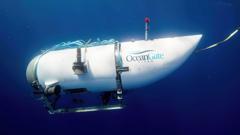PORTLAND, Maine (AP) — Engineering failures were at the heart of the Titan submersible's catastrophic implosion that claimed the lives of five individuals en route to the Titanic wreck site, according to a recent report released by the National Transportation Safety Board (NTSB).
The detailed investigation revealed that the design flaws in the submersible's carbon fiber composite pressure vessel were significant, failing to meet critical strength and durability criteria. This prompted the NTSB to conclude that had the proper testing been conducted by OceanGate, the Titan’s operator, these issues might have been detected.
OceanGate's inadequate testing procedures contributed to a lack of awareness regarding the submersible’s true durability, ultimately leading to the tragic incident in June 2023.
As the Titan descended into the North Atlantic, it experienced a catastrophic implosion that resulted in the immediate death of all onboard, including OceanGate's CEO Stockton Rush, renowned underwater explorer Paul-Henri Nargeolet, and British adventurer Hamish Harding.
The NTSB report suggests that the emergency response could have been improved if OceanGate had adhered to standard emergency protocols, potentially allowing for quicker recovery efforts, even if a rescue were ultimately futile.
While this report aligns with the findings of an earlier investigation by the Coast Guard, which deemed the incident preventable, the NTSB has called for enhanced regulations pertaining to submersibles and other pressure vessels. This includes recommendations for commissioning an expert panel to develop safety standards for future deep-sea explorations.
The Titan's last voyage was on June 18, 2023, when contact was lost with its support vessel approximately two hours into the dive. A massive international search effort was initiated to locate the submersible, which concluded after it was determined there would be no survivors, raising serious concerns about safety in the emerging realm of private underwater exploration.


















